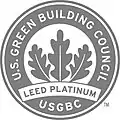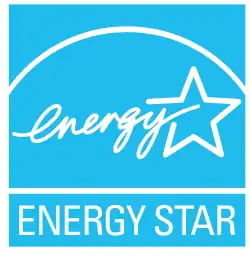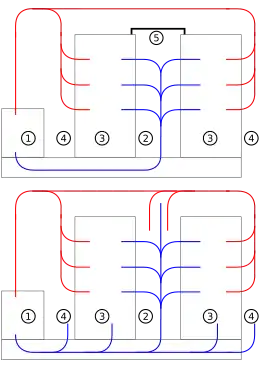Green data center
A green data center, or sustainable data center, is a service facility which utilizes energy-efficient technologies. They do not contain obsolete systems (such as inactive or underused servers), and take advantage of newer, more efficient technologies.
.jpg.webp)
With the exponential growth and usage of the Internet, power consumption in data centers has increased significantly. Due to the resulting environmental impact, increase in public awareness, higher cost of energy and legislative action, increased pressure has been placed on companies to follow a green policy. For these reasons, the creation of sustainable data centers has become essential in an environmental and a business sense.[1]
Energy use
The use of high-performance computing techniques has increased, trading energy consumption for increased performance. Industry estimates suggest that data centers consume three to five percent of the world's global energy.[2] According to an AFCOM State of the Data Center survey, 70 percent of data-center providers indicated that power density per rack has increased significantly since 2013. Managers have been forced to find new ways to power their data centers with renewable energy sources such as hydro,[3] solar, geothermal, and wind. More efficient technologies were developed to decrease data-center power consumption.[4]

Metrics
Several metrics have been developed to measure power efficiency in data centers. Power usage effectiveness (PUE) and carbon usage effectiveness (CUE) are two frequently-used metrics created by the Green Grid (TGG), a global consortium dedicated to advancing energy efficiency in data centers.
Power usage effectiveness
PUE was invented in 2007, and proposed new guidelines to measure energy use in data centers.
This ratio describes how much extra energy a data center needs to maintain IT equipment for every watt delivered to the equipment. The best PUE a data center can have is 1: an ideal situation, with no extra energy use. When PUE was introduced, studies found that the industry-average PUE was between 2.5 and 3. In more recent studies, the average PUE fell to about 1.7 by using this framework. PUE began the shift of the data-center industry towards energy efficiency.[5]
| PUE | 1.2 | 1.5 | 2 | 2.5 | 3 |
|---|---|---|---|---|---|
| Efficiency level[6] | Very efficient | Efficient | Average | Inefficient | Very inefficient |
Although PUE is the most-frequently-used metric for data centers to measure energy efficiency, its reliability is still debated;[7][8]
Carbon usage effectiveness
Carbon usage effectiveness (CUE) is another metric used to measure energy usage and sustainability in data centers. It is calculated with the following formula:[9]
Another way to express this formula is as the product of the carbon dioxide emission factor (CEF) and the PUE, where the CEF is the kg of produced for each kilowatt-hour of electricity:
- ×
Certifications


Data centers in the United States may apply to be certified as green data centers. The most widely used green building rating system is the Leadership in Energy and Environmental Design (LEED). Developed by the U.S. Green Building Council, it is available in several categories. Depending on ratings, data centers may receive a silver, gold or platinum certification. The platinum certification is given to data centers with the highest level of environmentally-responsible construction and efficient use of resources.[10]
Data centers may also be certified under the National Data Center Energy Efficiency Information Program by Energy Star, part of an initiative by the U.S. Environmental Protection Agency and the U.S. Department of Energy. The program certifies buildings and consumer products for energy efficiency. Only data centers which are in the top 25 percent in energy performance may receive Energy Star certification.[11]
Technologies
Several technologies increase efficiency and decrease energy consumption in data centers.
Low-power servers

Low-power servers are more energy-efficient than conventional servers in data centers. They use the technology of smartphone computing, which tries to balance performance with energy consumption. The first low-power servers were introduced in 2012 by large IT providers such as Dell and Hewlett-Packard. Used correctly, low-power servers can be much more efficient than conventional servers. They can have a significant impact on data-center efficiency, decreasing power consumption and the operating cost of cooling facilities.[12]
Modular data centers
A modular data center is a portable data center which can be placed anywhere data capacity is needed. Compared with traditional data centers, they are designed for rapid deployment, energy efficiency and high density. These ready-made data centers in a box became very popular. The HP EcoPod modular data center supports over 4,000 data centers with a PUE rating of 1.05 in and free-air cooling.[12]
Free air cooling

Free air cooling systems uses external wind instead of traditional data-center computer room air conditioner (CRAC) units.[13] Although outdoor air still needs to be filtered and moisturized, much less energy is required to cool a data center with this method. Outdoor air temperature is an issue here, and the data center's location plays a critical role in this technology.[14]
Hot and cold aisle containment
In this method, the rows of racks are aligned with the backs of the servers facing each other; the aisles are enclosed, to capture the air. In hot aisle containment, the heat produced by the servers is pumped to the cooling units. In cold aisle containment, cold air is pumped to the enclosed aisles. Both containment methods are more effective than traditional cooling technologies, and can help reduce energy consumption (and its impact). Although it may be more difficult to implement, hot aisle containment is more effective than cold aisle containment.[15][16]
Reusing waste heat
Data centers use electric power, releasing more than 98 percent of this electricity as heat. Waste heat can be actively reused, and a data center becomes a closed-loop heating system with no waste. Examples include:
Ultrasonic humidification
Some humidity is necessary for data centers to work efficiently and prevent damage to devices and servers. Ultrasonic humidification uses ultrasound to create moisture, using 90 percent less energy than conventional methods such as resistance steam humidifiers.[18]
Evaporative cooling
Evaporative cooling reduces heat by the evaporation of water. Two main methods are used: evaporation pads and high-pressure spray systems. With evaporation pads – the more popular method – air is drawn through the pads, making water evaporate and cooling the air. The other technique, high-pressure spray systems, needs a larger area and consumes more energy with pumps. Evaporative cooling is dependent on geographical location and season, because both affect the moisture level of the air. Compared to traditional mechanical cooling systems, evaporative cooling generally uses significantly less electricity.[19]
Investment in Green Data Center
According to a new study by Arizton Advisory & Intelligence, the total investment in the green data center market across the globe marked $35.58 billion in 2021. The investment is expected to grow by a CAGR of 7.6%.[20]
References
- "Sustainable data centers: 5 key questions".
- "Focus Green datacenter" (PDF). docs.media.bitpipe.com.
- "Hydropower datacenter in Switzerland". datacenterlight.ch/en-us/cms/hydropower/.
- Inc., Advanced Solutions International. "AFCOM Home". www.afcom.com.
{{cite web}}:|last=has generic name (help) - "Analysis of performance metrics for data center efficiency – should the Power Utilization Effectiveness PUE still be used as the main indicator? (Part 1): REHVA". www.rehva.eu.
- "PUE Calculator – 42U".
- "Green Power Usage Effectiveness - GPUE". 7 March 2012. Archived from the original on 3 March 2016. Retrieved 1 July 2018.
- "Are you Measuring your Green KPI's like Power Usage Effectiveness (PUE) = Cooling + Power + Lighting + IT/ IT - Anaeko". 13 May 2013.
- "White paper guidelines" (PDF). tmp2014.airatwork.com. Archived from the original (PDF) on 2018-09-03. Retrieved 2018-07-01.
- "What is LEED Certification for Data Centers? - Lifeline Data Centers". 23 October 2014.
- "Energy star certification". datacenterknowledge.com. 27 August 2012. Retrieved September 1, 2018.
- "Top technologies that can make your data centre green".
- "Free-air cooling – using natural cooling in the data centre".
- "Whitepapers". www.stulz.de.
- "Impact of Hot and Cold Aisle Containment on Data Center Temperature and Efficiency" (PDF). Retrieved 2018-09-04.
- "Think Inside the Box & Implement Containment for Energy Savings". www.greenhousedata.com.
- "How to Reuse Waste Heat from Data Centers Intelligently". 10 May 2016.
- "Fact sheet" (PDF). www.energystar.gov.
- "How Free is Evaporative Cooling in the Data Center". www.greenhousedata.com. Archived from the original on 2018-09-03. Retrieved 2018-07-01.
- "Green Data Center Market, Size, Global Industry Report 2027".